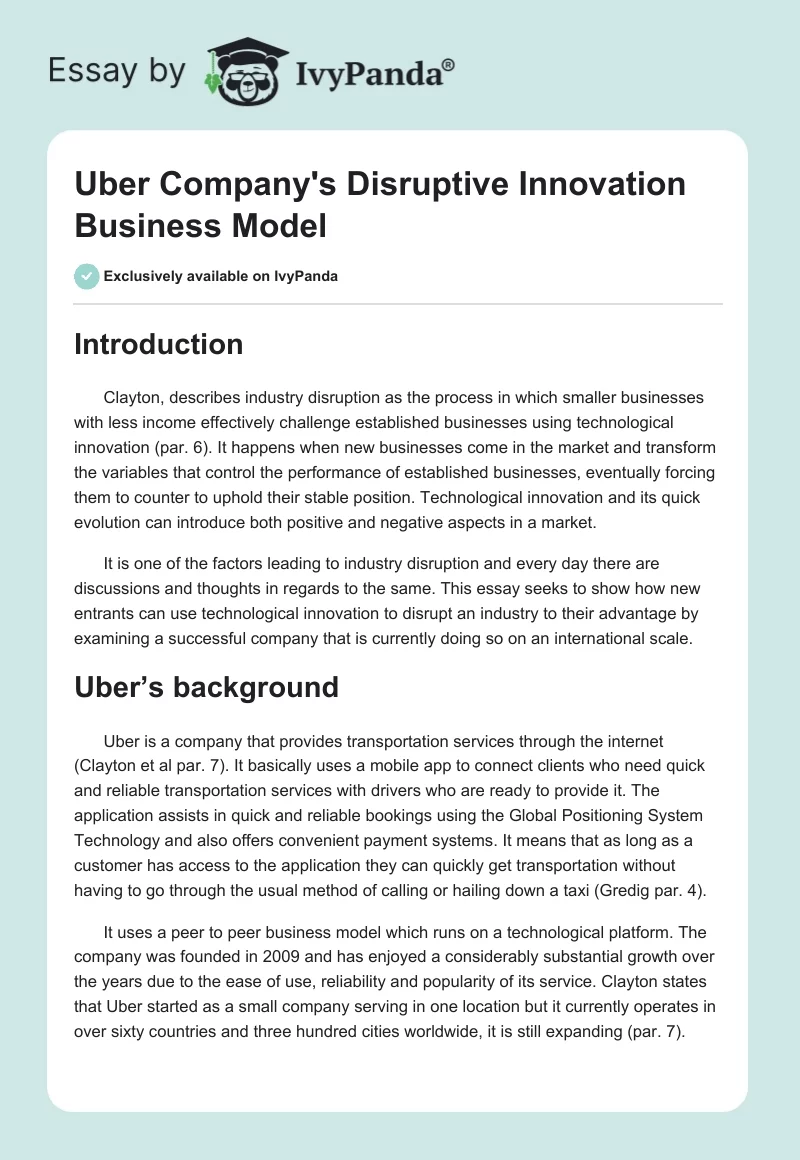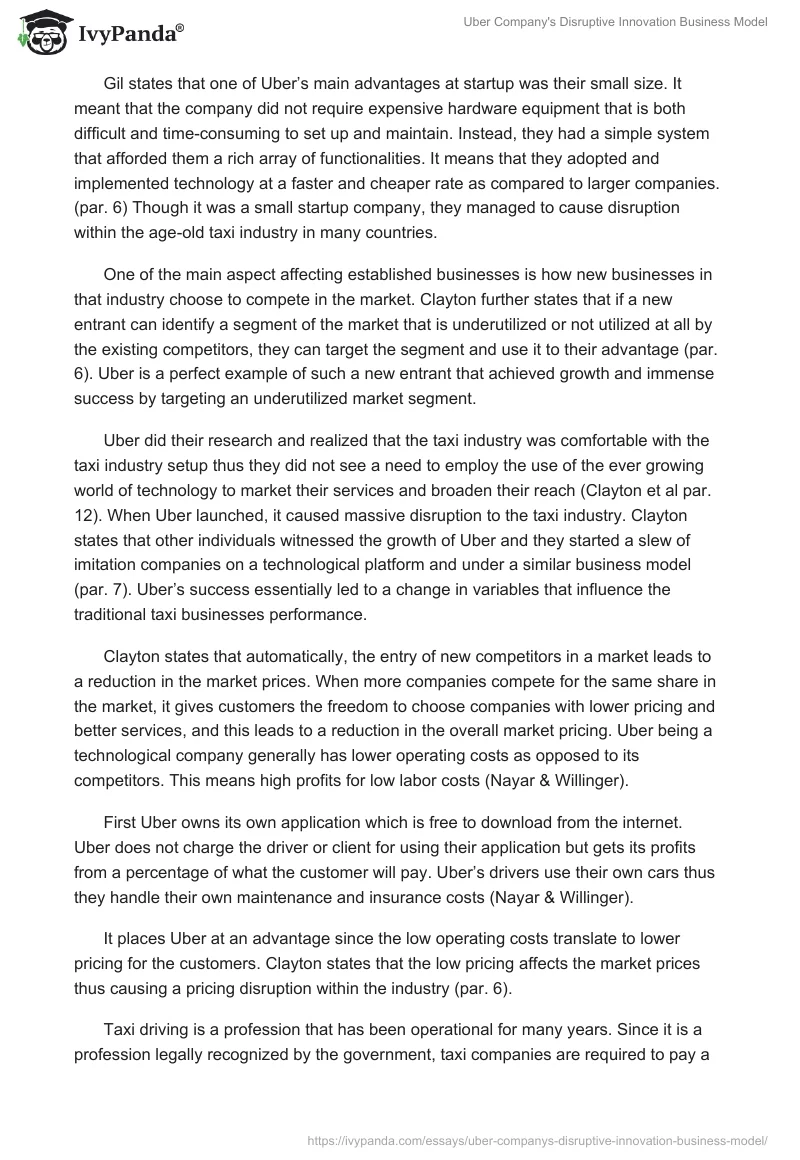Introduction
Clayton, describes industry disruption as the process in which smaller businesses with less income effectively challenge established businesses using technological innovation (par. 6). It happens when new businesses come in the market and transform the variables that control the performance of established businesses, eventually forcing them to counter to uphold their stable position. Technological innovation and its quick evolution can introduce both positive and negative aspects in a market.
It is one of the factors leading to industry disruption and every day there are discussions and thoughts in regards to the same. This essay seeks to show how new entrants can use technological innovation to disrupt an industry to their advantage by examining a successful company that is currently doing so on an international scale.
Uber’s background
Uber is a company that provides transportation services through the internet (Clayton et al par. 7). It basically uses a mobile app to connect clients who need quick and reliable transportation services with drivers who are ready to provide it. The application assists in quick and reliable bookings using the Global Positioning System Technology and also offers convenient payment systems. It means that as long as a customer has access to the application they can quickly get transportation without having to go through the usual method of calling or hailing down a taxi (Gredig par. 4).
It uses a peer to peer business model which runs on a technological platform. The company was founded in 2009 and has enjoyed a considerably substantial growth over the years due to the ease of use, reliability and popularity of its service. Clayton states that Uber started as a small company serving in one location but it currently operates in over sixty countries and three hundred cities worldwide, it is still expanding (par. 7).
Gil states that one of Uber’s main advantages at startup was their small size. It meant that the company did not require expensive hardware equipment that is both difficult and time-consuming to set up and maintain. Instead, they had a simple system that afforded them a rich array of functionalities. It means that they adopted and implemented technology at a faster and cheaper rate as compared to larger companies. (par. 6) Though it was a small startup company, they managed to cause disruption within the age-old taxi industry in many countries.
One of the main aspect affecting established businesses is how new businesses in that industry choose to compete in the market. Clayton further states that if a new entrant can identify a segment of the market that is underutilized or not utilized at all by the existing competitors, they can target the segment and use it to their advantage (par. 6). Uber is a perfect example of such a new entrant that achieved growth and immense success by targeting an underutilized market segment.
Uber did their research and realized that the taxi industry was comfortable with the taxi industry setup thus they did not see a need to employ the use of the ever growing world of technology to market their services and broaden their reach (Clayton et al par. 12). When Uber launched, it caused massive disruption to the taxi industry. Clayton states that other individuals witnessed the growth of Uber and they started a slew of imitation companies on a technological platform and under a similar business model (par. 7). Uber’s success essentially led to a change in variables that influence the traditional taxi businesses performance.
Clayton states that automatically, the entry of new competitors in a market leads to a reduction in the market prices. When more companies compete for the same share in the market, it gives customers the freedom to choose companies with lower pricing and better services, and this leads to a reduction in the overall market pricing. Uber being a technological company generally has lower operating costs as opposed to its competitors. This means high profits for low labor costs (Nayar & Willinger).
First Uber owns its own application which is free to download from the internet. Uber does not charge the driver or client for using their application but gets its profits from a percentage of what the customer will pay. Uber’s drivers use their own cars thus they handle their own maintenance and insurance costs (Nayar & Willinger).
It places Uber at an advantage since the low operating costs translate to lower pricing for the customers. Clayton states that the low pricing affects the market prices thus causing a pricing disruption within the industry (par. 6).
Taxi driving is a profession that has been operational for many years. Since it is a profession legally recognized by the government, taxi companies are required to pay a yearly permit fee as per the city regulations. The taxi company drivers are also individually charged for their driving permits. Gil states that taxi drivers have opted to quit their traditional jobs and sign up with Uber (par. 4). This has caused a major disruption in the traditional taxi industry as their sales have significantly reduced.
Uber reiterates that it merely provides a technology that enables ease of networking and is not a taxi company thus it should not be subjected to paying permits as well as conform to taxi licensing standards. Gill also states the companies are going at a loss since they are paying permit and insurance charges, yet a majority of customers use the Uber service.
Conclusion
In conclusion, Uber’s employment of a clever business model and the use of the technological platform aided in their sudden growth. (Gredig par. 4) The same caused a disruption in the taxi industry. Gredig states that the fact that Uber is not required to follow regulations that traditional taxi companies do means that they have an unfair advantage that enables them to cause even more disruption in the industry.
Works Cited
Clayton, M. Christensen, Raynor E. Michael, McDonald, Rory. “What Is Disruptive Innovation?” Harvard Business Review. 2015. Web.
Gil, Elad. “Uber And Disruption.” TechCrunch. 2014. Web.
Gredig, Peter. “Uber disruptive technologies challenge old business models.” Technology and Innovation. Farm Credit Canada. n.d. Web.
Nayar Nandkumar, Willinger G. Lee. “Financial Implications of the Decision to Increase Reliance on Contingent Labor.” Pennysylvania State University 32.4 (2001)662-663. Web.


